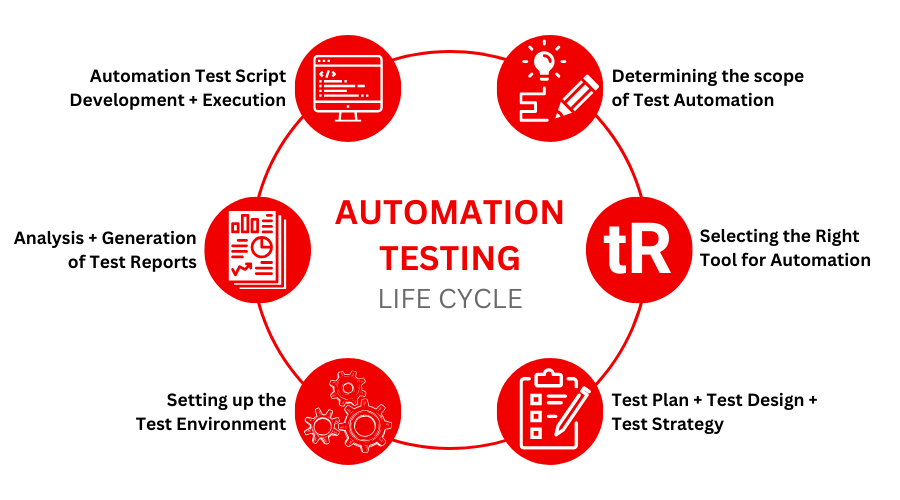Exactly How Automation Testing Reinvents Quality Control Processes
Exactly How Automation Testing Reinvents Quality Control Processes
Blog Article
From Handbook to Automated Screening: A Comprehensive Overview to Transitioning Efficiently and Successfully
In the world of software testing, the shift from manual to automated procedures has actually become an increasingly important shift for organizations seeking to enhance efficiency and precision in their screening practices. As innovation proceeds to advance, the need for smooth and reliable automatic testing techniques has never ever been extra pressing. The journey from handbook to automated testing is not without its difficulties, but when approached strategically and with a clear strategy in mind, the advantages can be considerable - automation testing. In this detailed guide, we will check out essential steps and factors to consider essential for a successful change, from the first selection of devices to the assimilation of automation into existing operations. Stay tuned to discover the understandings that will aid lead the way for a smoother and extra efficient testing process.
Advantages of Automated Examining
Automated testing uses many advantages, boosting efficiency and accuracy in software application advancement procedures. One primary advantage is the considerable reduction in screening time. Automated tests can be run simultaneously on numerous devices and running systems, significantly speeding up the screening stage contrasted to hand-operated testing. This raised efficiency permits faster feedback on the quality of the software application, enabling designers to determine and resolve concerns quickly.
In addition, automated testing guarantees a greater degree of accuracy in detecting issues. Consistency in testing is also improved, as automated examinations perform the very same actions precisely each time they are run.
Picking the Right Tools

First of all, evaluate your objectives and needs. Recognize the range of your project, the technologies involved, and the ability of your team. This analysis will certainly aid you determine the abilities and attributes you need in your testing tools.
Second of all, take into consideration the compatibility of the tools with your existing procedures and systems. Smooth integration with your present software application advancement lifecycle is important to make certain a smooth shift to automation.
Additionally, examine the scalability and adaptability of the tools. As your screening needs advance, the tools should have the ability to adapt and fit changes properly.
Finally, element in the assistance and neighborhood around the tools. Durable support and an energetic individual area can give beneficial sources and assistance when executing automated screening. By very carefully thinking about these aspects, you can choose the right devices that line up with your needs and set the phase for an effective shift to automated screening.
Writing Efficient Examination Manuscripts

When crafting examination scripts, it is vital to take into consideration the particular needs of the software application being tested and make sure that the scripts address all essential capabilities. Clear and descriptive naming conventions for examination manuscripts and test situations can boost readability and maintainability. Furthermore, including error handling systems within the examination manuscripts can assist in recognizing and dealing with concerns quickly.
In addition, organizing test manuscripts into modular elements can enhance reusability and scalability, reducing redundancy and improving efficiency in examination script maintenance. Normal reviews and updates to check scripts are important to maintain rate with developing software program requirements and performances. By following these principles, testers can produce efficient and durable examination manuscripts that add considerably to the success of automated testing processes.
Integrating Automation Into Workflows
Effective assimilation of automation tools right into existing workflows enhances procedures and boosts performance within software advancement cycles. When integrating automation right into operations, it is important to determine repeated jobs that can be automated to conserve time and minimize human error. By effortlessly incorporating automated screening tools like Selenium or Appium into the software advancement lifecycle, teams can attain look these up faster responses on code changes, causing quicker pest detection and resolution. This integration enables for continuous testing throughout the growth process, ensuring that any concerns are identified beforehand, resulting in higher software program top quality. Furthermore, automation can be used to trigger examinations immediately after each code commit, giving instant recognition and freeing up testers to concentrate on even more complicated scenarios. Correct combination of automation tools calls for collaboration in between advancement, testing, and procedures groups to develop a unified workflow that maximizes effectiveness and effectiveness in supplying high-grade software.
Guaranteeing a Smooth Change
Efficiently transitioning to automated testing includes careful preparation and careful execution to decrease disruptions and take full advantage of performance in the software development process - automation testing. To make certain a smooth transition, it is crucial to begin by conducting a thorough evaluation of the existing screening procedures and determining locations where automation can bring one of the most significant benefits. Engaging with all stakeholders at an early stage in the procedure, consisting of programmers, testers, and project managers, is vital for garnering support and buy-in for the automation effort
Communication is crucial throughout this shift stage. Clear interaction of the goals, benefits, and expectations of automated testing assists to handle any kind of resistance or worries that might develop. Furthermore, giving adequate training and resources for employee to upskill in automation devices and strategies is vital for guaranteeing a successful shift.

Conclusion
In conclusion, transitioning from manual to automated testing provides many advantages, consisting of raised efficiency and reliability. By selecting the suitable tools, writing effective test scripts, and incorporating automation seamlessly into workflows, organizations can ensure a effective and smooth change. It is necessary to embrace automation as a valuable possession in software testing procedures to boost general high quality and efficiency.
In the realm of software program testing, the shift from guidebook to automated procedures has check out here actually come to be an increasingly important shift for companies looking for to boost efficiency and accuracy in their screening techniques. Automated tests can be run concurrently on several devices and running systems, drastically speeding up the screening phase compared to hand-operated screening. Consistency in screening is likewise improved, as automated tests perform the same actions exactly each time they are run.To ensure the effective application of picked screening tools, the production of efficient test manuscripts plays an important role in confirming the performance and performance of automated processes my company - automation testing. By adhering to these principles, testers can create durable and effective examination scripts that contribute substantially to the success of automated testing procedures
Report this page